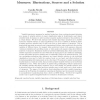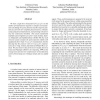1578 search results - page 75 / 316 » Algorithmic randomness of continuous functions |
116
click to vote
BMCBI
2007
14 years 9 months ago
2007
Variable importance measures for random forests have been receiving increased attention as a means of variable selection in many classification tasks in bioinformatics and relate...
FOCS
2008
IEEE
15 years 4 months ago
2008
IEEE
We show a tight lower bound of Ω(N log log N) on the number of transmissions required to compute several functions (including the parity function and the majority function) in a...
ICML
2004
IEEE
15 years 10 months ago
2004
IEEE
This paper extends previous work on the Skewing algorithm, a promising approach that allows greedy decision tree induction algorithms to handle problematic functions such as parit...
SIGSOFT
2007
ACM
15 years 10 months ago
2007
ACM
We improve on previous recommender systems by taking advantage of the layered structure of software. We use a random-walk approach, mimicking the more focused behavior of a develo...
GECCO
2005
Springer
15 years 3 months ago
2005
Springer
A Quasi-Monte-Carlo method based on the computation of a surrogate model of the fitness function is proposed, and its convergence at super-linear rate 3/2 is proved under rather ...


